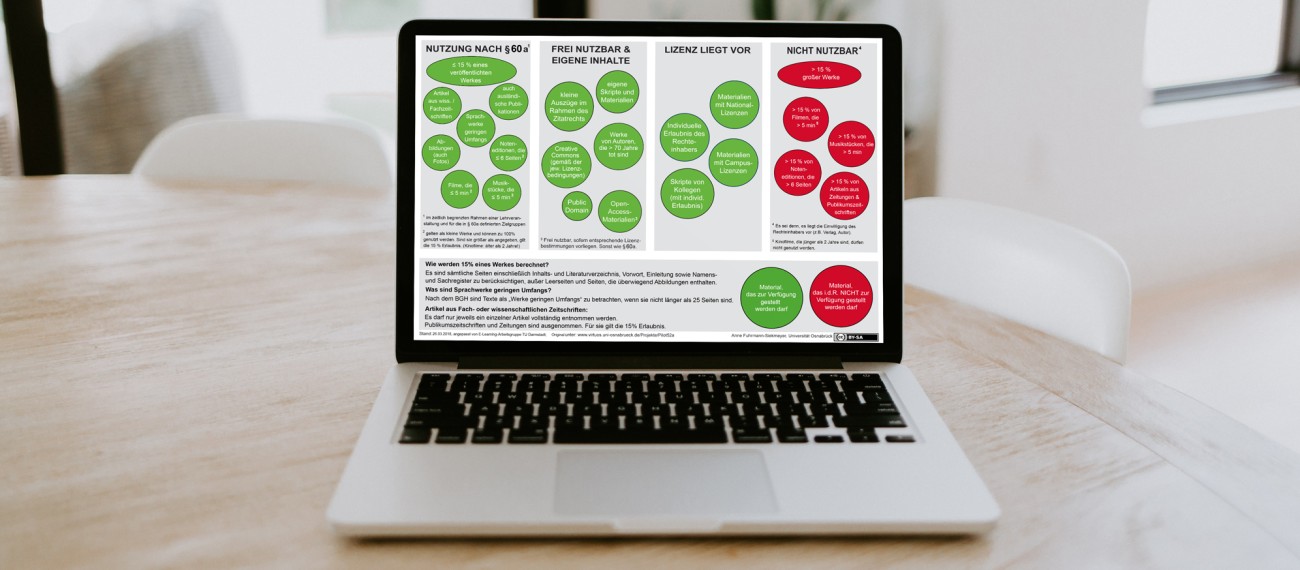E-Learning Arbeitsgruppe (HDA & HRZ)

Rechtsfragen bei digitaler Lehre
Im Überblick
Bei Rechtsfragen in der Lehre spielt oftmals das Urheberrecht eine zentrale Rolle. Wir haben deshalb in diesem Bereich die wichtigsten Themen rund um das Urheberrecht in der Hochschullehre für Sie zusammen gestellt – sowie Antworten auf konkrete Fragestellungen und weiterführende Informationsquellen, die wir als hilfreich erachten.
Welche Materialien dürfen in der Hochschullehre elektronisch zur Verfügung gestellt werden (gemäß § 60a UrhG)?
Beispielszenarien und Rechtliche Überlegungen zu konkreten Fragestellungen
Informieren Sie sich über Datenschutz an der TU Darmstadt
Erfahren Sie beispielsweise, wer die Ansprechpartner*innen zum Thema Datenschutz an der TU Darmstadt sind: www.tu-darmstadt.de/datenschutz
Erfahren Sie, wie Sie selbst eine orientierende Einschätzung zur Nutzung digitaler Tools hinsichtlich des Datenschutzes vornehmen können.
Weitere hilfreiche Informationsquellen

Urheberrecht in der Wissenschaft - Ein Überblick für Forschung, Lehre und Bibliotheken
Handreichung des Bundesministeriums für Bildung und Forschung (BMBF)
FAQ rund um Urheberrecht
Ausführliche „Copyright FAQ Hochschullehre“ (wird in neuem Tab geöffnet) der Technische Hochschule Würzburg-Schweinfurt.
Praxisleitfaden zum Recht bei E-Learning, OER und Open Content
Von Rechtsanwalt Dr. Till Kreutzer & Tom Hirche
Rechtsfragen zur Digitalisierung in der Lehre (wird in neuem Tab geöffnet)
Erklärvideos zu Rechtsfragen im Bereich E-Learning an Universitäten und Hochschulen
Innerhalb von kurzen Selbstlernkursen sind Erklärvideos zu folgenden Themen aufbereitet (von der Goethe-Universität Frankfurt):
Informationsportal "iRIGHTS.info"
- Urheberrecht für LERNENDE: Häufige Fragen und Antworten
- Handreichung zu „Audiovisuelle Materialien in Forschung und Lehre – eine Übersicht zu urheberrechtlichen Aspekten“
- „Klicksafe“ Kampagne – Mehr Sicherheit im Internet durch Medienkompetenz
Ratgeber-Broschüren, u.a. zu den Themen:- Nicht alles, was geht, ist auch erlaubt! Urheber- und Persönlichkeitsrechte im Internet
- Spielregeln im Internet: Durchblicken im Rechte-Dschungel









